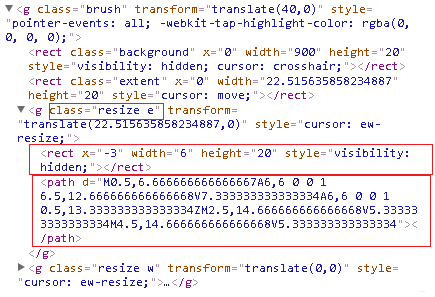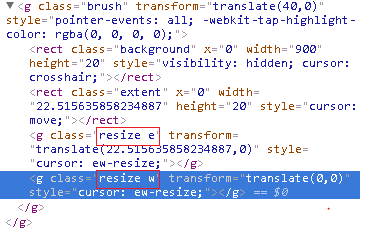Brush extent needs to be changed only from a dropdown as shown here: https://jsfiddle.net/dani2011/67jopfj8/3/
Need to disable brush extending by:
1) Extending an existing brush using the handles/resize-area of the brush
Gray circles are the handels:
2) Dragging a new brush by clicking on the brush background, where the haircross cursor appears.
JavaScript file
Removed the handles of the brush:
timeSlider.on('preRedraw',function (chart)
{
var timesliderSVG = d3.select("#bitrate-timeSlider-chart").selectAll("g.brush").selectAll("g.resize").selectAll("*").data(data[0]).exit().remove();})
If using css instead:
#bitrate-timeSlider-chart g.resize {
display:none;
visibility:hidden;
Now it looks like this:
The rect and the path elements inside "resize e","resize w" were removed:
However,the "resize e", "resize w" for extanding the brush still exist:
g.resize.e and g.resize.w dimesions are 0*0:
Furthurmore,after deleting "resize e","resize w" in the "developer tools/elements" in chrome,they reappear after moving the brush.
Tried to remove the resize-area in brushstart,brush,brushend:
timeSlider.on('renderlet', function (chart) {
var brushg = d3.select("#bitrate-timeSlider-chart").selectAll("g.brush");
var resizeg = brushg.selectAll("g.resize").selectAll("*").data(data[0]);
var timesliderSVG4 =
brushg.on("brushstart", function () {resizeg.exit().remove()}).on("brush", function () { resizeg.exit().remove() }).on("brushend", function () {resizeg.exit().remove() })
dc.js file
Tried to change setHandlePaths,resizeHandlePath:
1) Remarked the _chart.setHandlePaths(gBrush):
_chart.renderBrush = function (g) {....
// _chart.setHandlePaths(gBrush);
...}
2) Changed _chart.setHandlePaths = function (gBrush) for example by removing the gbrush.path:
// gBrush.selectAll('.resize path').exit().remove();
3) Remarked/changed _chart.resizeHandlePath = function (d) {...}.
d3.js file
1) Remarked/changed resize such as:
mode: "move" //mode: "resize" ,
var resize = g.selectAll(".resize").data(resizes[0], d3_identity);
Using resizes[0] disable the brush rendering on the background but still can re-extend the existing brush
2) Remarked/changed d3_svg_brushResizes
3) In d3.svg.brush = function():
a) Added .style("display","none"):
background.enter().append("rect").attr("class", "background").style("visibility", "hidden").style("display", "none").style("cursor", "none");
b) background.exit().remove();
The cursor now is "pointer" instead of "haircross" extending the brush to a full width
c) d3_svg_brushCursor disabled makes the whole brush disappear
4) Changed the pointer-events as specified here: https://developer.mozilla.org/en/docs/Web/CSS/pointer-events
5) console.log in different places to track the different brush events:
function d3_event_dragSuppress(node) {
console.log("here2 ");
}
if (d3_event_dragSelect) {
console.log("here3 d3_event_dragSelect");
...
}
return function (suppressClick) {
console.log("suppressClick1");
...
var off = function () {
console.log("suppressClick2");
...
w.on(click, function () {
console.log("suppressClick3")
...
function d3_mousePoint(container, e) {
console.log("d3_mousePoint1")
...
if (svg.createSVGPoint) {
console.log("createSVGPoint");
...
if (window.scrollX || window.scrollY) {
console.log("createSVGPoint1");
svg = d3.select("body").append("svg").style({
...
function dragstart(id, position, subject, move, end) {
console.log("dragstart")
...
function moved() {
console.log("moved ");
console.log("transition1");
...
if (d3.event.changedTouches) {
console.log("brushstart1");
...
} else {
console.log("brushstart2");
..
if (dragging) {
console.log("dragging4");
....
if (d3.event.keyCode == 32) {
if (!dragging) {
console.log("notdragging1");
...
function brushmove() {
console.log("brushmove");
...
if (!dragging) {
console.log("brushmove!dragging");
if (d3.event.altKey) {
console.log("brushmove!dragging1");
...
if (resizingX && move1(point, x, 0)) {
console.log("resizeXMove1");
...
if (resizingY && move1(point, y, 1)) {
console.log("resizeYMove1");
...
if (moved) {
console.log("moved");
...
}
function move1(point, scale, i) {
if (dragging) {
console.log("dragging1");
...
if (dragging) {
console.log("dragging2");
...
} else {
console.log("dragging10");
...
if (extent[0] != min || extent[1] != max) {
console.log("dragging11");
if (i) console.log("dragging12"); yExtentDomain = null;
console.log("dragging13");
function brushend() {
console.log("brushend");
...
The two changes that seemed to get closest to the needed result are in d3.js:
1) Using resizes[0] disables the brush rendering on the background but still can re-extend the existing brush
var resize = g.selectAll(".resize").data(resizes[0], d3_identity);
2) Removing the brush's background changes the cursor to "pointer" instead of "haircross",extending the brush to a full width only when clicking on the graph
`background.exit().remove();`
Any help would be very appreciated!







